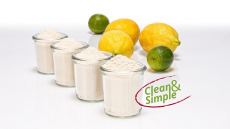Choose optimal thickening agent to boost flavour, lower salt
lowered, by choosing the optimal starch thickener, say scientists,
a result that could have big implications for the food industry.
"What this research does suggest is that by optimising the thickening system we can maximize the salt perception for a given salt content," co-researcher of the study, Professor John Mitchell, told FoodNavigator.com.
Increasing thickness (viscosity) of hydrocolloids is generally accepted as decreasing flavour perception, however the new study from the University of Nottingham, in collaboration with Nestlé, adds to other studies that show the choice of the thickening agent also significantly effects flavour and texture.
Starch is the most commonly used thickener in the food industry, but flavour perception from starch hydrocolloids has surprisingly only been the subject of limited study.
"The aim of the present study was to investigate the effect of starch thickener type on flavour perception in a warm, savoury model system," explained the researchers in the journal Food Hydrocolloids (Vol. 20, pp. 855-862).
The researchers made hydrocolloids from three different types of starch, unmodified wheat starch, waxy maize starch (both from Sigma) and modified waxy maize starch (National Starch, UK), and the non-starch thickener, hydroxypropylmethyl cellulose (HPMC, from Methocel, Dow Company), representative of other thickening agents such a guar gum.
Basil flavouring (0.5 per cent, Fermenich, Switzerland) and salt (0.5 per cent w/w, Co-op table salt) were added to the water, starch pastes.
To test the hypothesis that viscosity and thickener type affected flavour perception, five different viscosities of the four thickening agents were prepared, ranging from 80 to 480 mPa s.
The pastes were tested by 14 panellists, who quantitatively rated the basil flavour and salt perception, and qualitatively rated the texture for the four hydrocolloids at five different viscosities.
For all hydrocolloids, the basil flavour and salt perception decreased with increasing viscosity. All three starch thickening agents performed better than HPMC at all viscosities, while the modified waxy maize starch performed the best for both measurements.
When asked to anecdotally describe the texture, the modified waxy maize starch was 'smooth', the wheat starch was 'smooth but slightly powdery', the unmodified waxy maize starch was 'globular', while the HPMC hydrocolloid was described as 'sticky'.
"Perceived taste, and hence flavour, from viscous solutions is related to the efficiency with which the solution mixes with saliva in the mouth. Starch pastes, where the granular structure is largely retained, mix efficiently and this is responsible for their different mouthfeel and increased flavour perception in comparison with random coil polysaccharides," wrote the researchers.
The research has significant implications for the food industry, and especially in terms of the push to lower salt levels.
Professor Mitchell explained that cross-linked starches, like the modified waxy maize starch, stay as granules. The mixing of granules is better than the for the random coil polymers like HPMC. The dispersion of the thickening agents clearly has an effect on texture and flavour perception.
Optimising the thickening agent, Professor Mitchell said, could maximise the perception of salt in the hydrocolloid, meaning that less salt is needed to produce the same sensory result.
The estimated intake of salt in Europe is currently between 10 and 15 grams per day, but government agencies and stroke and heart foundation societies have all recommended cutting salt intake by half, including the WHO which recommends no more than 5 grams of salt intake per day for every adult in the world.
The researchers from Nottingham, a university with strong industrial links and expertise in hydrocolloids and sensory science, have also studied the release of volatiles from the same systems that affect aroma perception, with the results due for publication soon.




























